Plant’s world
The vegetation of Poland consists of some 2,250 species of seed plants, 630 mosses, 200 liverworts, 1,200 lichens, and 1,500 fungi. Elements those appertaining to the temperate belt of the Northern Hemisphere are dominant among the seed plants.
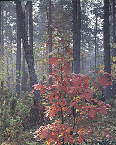 Forests occupy 28% of the country’s area. The most commons in Poland are pine forests mixed with oak, birch and rowan trees. The undergrowth in these forests consists of moss, lichen, heather and fungi. Apart from the typical woods, there are mixed forests with pines, oaks, birches, spruces and firs, usually having rich brushwood. The forests of these two types occupy large areas of such virgin forests as Puszcza Bialowieska, Puszcza Augustowska, Puszcza Kampinoska, Bory Tucholskie and Bory Noteckie.
Forests occupy 28% of the country’s area. The most commons in Poland are pine forests mixed with oak, birch and rowan trees. The undergrowth in these forests consists of moss, lichen, heather and fungi. Apart from the typical woods, there are mixed forests with pines, oaks, birches, spruces and firs, usually having rich brushwood. The forests of these two types occupy large areas of such virgin forests as Puszcza Bialowieska, Puszcza Augustowska, Puszcza Kampinoska, Bory Tucholskie and Bory Noteckie.
Deciduous, mixed deciduous-fir and mixed deciduous-larch forests make up the forests growing on dry ground which are characterised by richness of trees, shrubbery and herbs. They are embellished by oaks, hornbeams, beeches and limes. The banks of rivers and the shores of lakes are covered with meadow forests with alders, poplars, willows, elms and ashes, while the peat bogs are covered with alder forests and particularly picturesque willow thickets.
Forests growing on dry ground and marsh forests are common on lowlands and on highlands. In the upper parts of the mountains we find coniferous forest consisting of dwarf mountain pines, dwarf firs and resisting hard climatic conditions stone pines.
In the southeast of Poland a fragment of the forest-steppe vegetation zone intrudes.
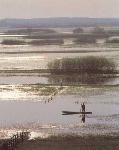 Significant plant communities are marshes. The marsh meadows found in the Biebrza River valley are preserved in their most natural state. Here we find the biggest and the best preserved concentration of swamps in Europe. The whole area is a natural reservation.
Significant plant communities are marshes. The marsh meadows found in the Biebrza River valley are preserved in their most natural state. Here we find the biggest and the best preserved concentration of swamps in Europe. The whole area is a natural reservation.
Unique in whole Europe are the communities of plants of tundra and forest-tundra character found in the Poleski Park Narodowy (Poleski National Park). Among very valuable objects there are: the community of old oaks near Poznan, a group of ancient trees in the Puszcza Bialowieska forest, the only specimen of sequoia in Poland and the over one-thousand-year-old yew.
The typical Polish plants are, among others: the Polish larch and the birch from the Ojcow region. Various floral borders for example of the ordinary pine, fir, Swedish sorb and beech, pass through the territory of Poland.
There are few endemic species: the Polish larch (Larix polonica) and the Ojców birch (Betula oycoviensis) are two examples.
Animal’s world
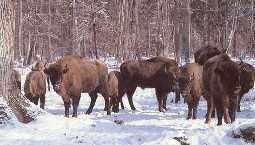 The Polish fauna is characteristic for European and Western Siberian forests. The vertebrate fauna includes nearly 400 species, including many types of mammals and more than 200 native birds. Particularly noteworthy are the European bisons in the Bialowieska, Borecka and Knyszynska virgin forests and in the Bieszczady region. Poland has decisively contributed to the restoration and preservation of this magnificent species, and holds the first place in the world as far as numerosity of these animals is concerned. European bisons, as well as small Polish horses called tarpans, can be seen at large only in Poland.
The Polish fauna is characteristic for European and Western Siberian forests. The vertebrate fauna includes nearly 400 species, including many types of mammals and more than 200 native birds. Particularly noteworthy are the European bisons in the Bialowieska, Borecka and Knyszynska virgin forests and in the Bieszczady region. Poland has decisively contributed to the restoration and preservation of this magnificent species, and holds the first place in the world as far as numerosity of these animals is concerned. European bisons, as well as small Polish horses called tarpans, can be seen at large only in Poland.
Very numerous representatives of the Polish fauna are: roe deer’s, deer’s, fallow deer’s, wild boars, hares, foxes, badgers and martens. More and more frequent is beaver.The biggest representative of the deer family is the elk, whose main refuge are
More and more frequent is beaver.The biggest representative of the deer family is the elk, whose main refuge are  the Bagna Biebrzanskie swamps. Among the rare species there are the wolf, lynx and, while the hardly accessible spiry crags of the Tatra Mountains are inhabited by the equally rare swiftly and deftly moving chamois and the skittish marmot. Brown bear and wildcat live in the mountain woods, and the chamois and marmot are found at the highest levels.
the Bagna Biebrzanskie swamps. Among the rare species there are the wolf, lynx and, while the hardly accessible spiry crags of the Tatra Mountains are inhabited by the equally rare swiftly and deftly moving chamois and the skittish marmot. Brown bear and wildcat live in the mountain woods, and the chamois and marmot are found at the highest levels.
In the offshore thickets of the lakeland region there live many species of ducks, wild geese, swans and grebes. The forest sand swamps of the lakeland region are inhabited by black storks, cormorants, cranes, herons, as well as by birds of prey such as sea eagle, golden eagle and osprey. On the whole territory of the country one can encounter owls, buzzards, kestrels and hawks.
thickets of the lakeland region there live many species of ducks, wild geese, swans and grebes. The forest sand swamps of the lakeland region are inhabited by black storks, cormorants, cranes, herons, as well as by birds of prey such as sea eagle, golden eagle and osprey. On the whole territory of the country one can encounter owls, buzzards, kestrels and hawks.
In the waters of the lakes we can find numerous species of fish, among them: the pike, eel, perch, European white fish and the bream. In some lakes and streams one can still without difficulty find the crayfish.
Plants and animals do not only create the beauty of Polish landscape. In four seasons of the year, though a keen observer will notice changeability of views and colours.
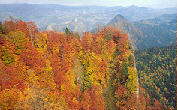 Spring timidly showing the ever deeper shades of green in order to finally burst out and astonish everybody with rich vegetation.
Spring timidly showing the ever deeper shades of green in order to finally burst out and astonish everybody with rich vegetation.
Summer is a time of abundance of flowers, fruits and waving grains.
The colours of autumn, are yellow and red of the leaves of deciduous trees and the purple patches of moorlands. It is the „golden Polish autumn”.
In winter the dominant colour is the white of the snow-covered fields, sharply contrasting with the almost black spots of the forests and coppices.
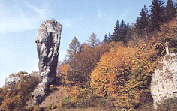 Amazing are also original rocks of various shapes. The most famous of them is the slender, widening upwards Hercules Club in the Ojcowski National Park. Extremely interesting is the so-called Stone City near Ciezkowice. Also noteworthy is the beautiful Koscieliska Valley located between precipitous slopes of high mountains and the extremely picturesque gate of the Dunajec River in the Pieniny Mountains. Magnificent creations of nature is the Crystal Cave in the Wieliczka saltmine. It is worth mentioning that the exploitation of salt in Wieliczka began in the 13th century. In the 17th century fine underground chapels and characteristic chambers connected by tunnels were built.
Amazing are also original rocks of various shapes. The most famous of them is the slender, widening upwards Hercules Club in the Ojcowski National Park. Extremely interesting is the so-called Stone City near Ciezkowice. Also noteworthy is the beautiful Koscieliska Valley located between precipitous slopes of high mountains and the extremely picturesque gate of the Dunajec River in the Pieniny Mountains. Magnificent creations of nature is the Crystal Cave in the Wieliczka saltmine. It is worth mentioning that the exploitation of salt in Wieliczka began in the 13th century. In the 17th century fine underground chapels and characteristic chambers connected by tunnels were built.
Protection of the natural heritage
Many of the Polish undisturbed landscapes are of particular natural value, and under careful protection in the form of national parks. There are currently 22 national parks in Poland, covering a total area of approximately 300,000 hectares. The national parks protect the most interesting landscapes, and in many cases, the only examples of endangered species of plants and animals in Poland. The Polish national parks play a significant role in the world system of protected areas. Six parks have been recognized as world biosphere reserves Babiogorski, Bialowieski, Bieszczadzki, Karkonoski, Slowinski, and Tatrzanski), one – Bialowieski – as an object of World Human Heritage, and two – Biebrzanski and Slowinski – have been made a part of the International Ramsar Convention of protection of waterways. All the national parks are open to tourism and enjoy enormous recognition among visitors. The uniqueness of the parks as well as the valuable historical objects preserved on their grounds are admired each year by almost 10 million people thanks to designated tourist routes, mainly foot-paths, educational trails, and canoe and sailing routes.
Wypłata pieniędzy w kasynie internetowym online wcale nie jest trudna. Gdy posiadamy konto w jakimś kasynie online, wpłaciliśmy depozyt i udało nam się wygrać jakieś pieniądze na jednej z legalnych gier, musimy przejść do działu z wypłatami. Znajduje się on najczęściej w panelu użytkownika. Tam wybieramy interesującą nas metodę płatności. Zwykle kasyno wymaga od graczy, aby użyli tej samej metody do wypłaty, co do wpłaty. Jeśli więc wpłaciliśmy depozyt przez BLIK albo kartę pre-paid Neosurf/Paysafecard, będziemy musieli zaznaczyć inną metodę płatniczą, na przykład e-portfel w rodzaju eZeeWallet czy MuchBetter albo kartę płatniczą Visa/Mastercard. Potem wpisujemy adres naszego e-portfela albo inne szczegóły umożliwiające identyfikację nas w systemie danego operatora płatniczego, uzupełniamy kwotę do wypłaty i… w zasadzie to wszystko. Kasyno skontaktuje się z nami, jeśli nastąpią jakieś problemy z płatnościami. W przeciwnym wypadku w ciągu maksymalnie trzech dni roboczych powinniśmy otrzymać przelew pieniężny z wygraną w kasynie gotówką.